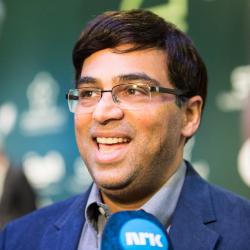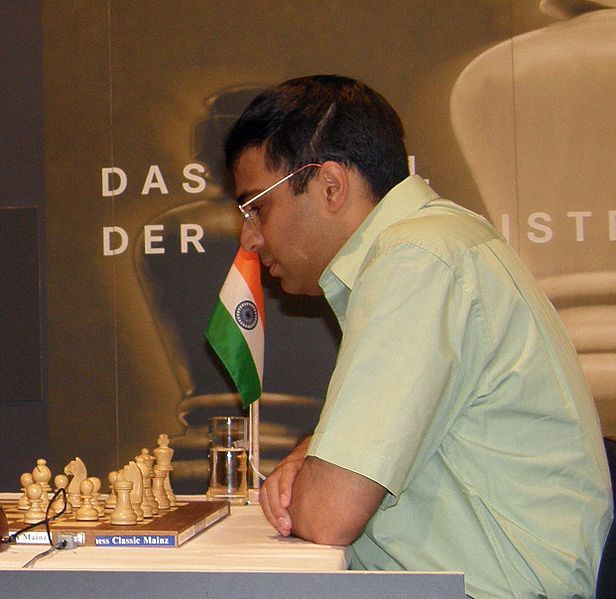GM Viswanathan Anand

Bio
The name Viswanathan is a patronymic, and the player should be referred to by his name, Anand.
Viswanathan Anand, the 15th undisputed chess champion and surely the greatest Indian chess player of all time, was born on December 11, 1969, in Mayiladuthurai in Tamil Nadu, the southeasternmost state in India. Anand, noted for playing quickly early in his career, competed for the classical championship in 1995 and was FIDE champion from 2000-2002 before claiming the reunited title in 2007. He held that title for six years until 2013 and has also had a productive post-championship career at an age when many other top players have retired.
Early Career Through 1980s
Anand began playing chess at six years old after learning the game from his mother. By the time he was 15, he was already an International Master after winning the 1984 Asian Junior Championship for players under 20. He followed that by winning the Indian Chess Championship every year from 1986 to 1988 as well as the World Junior Championship in 1987. At that time, three of the past four champions—Boris Spassky in 1955, Anatoly Karpov in 1969 and Garry Kasparov in 1980—had won the same tournament, perhaps foreshadowing Anand’s own achievements.
In 1988 Anand earned his GM title. In 1989 he tied for first at the Hoogovens tournament in Wijk aan Zee, the Netherlands (with Predag Nikolic, Zoltan Ribli, and Gyula Sax). It was his first of an eventual five first-place finishes in that tournament.
1990s
By 1990 Anand was already strong enough to participate in the Interzonal tournament for the 1993 championship cycle. By scoring 8½ out of 13 in the Swiss-style tournament, Anand finished in the top 11 to earn a spot in the 1991 Candidates tournament along with the four semifinalists of the previous Candidates. There Anand beat Alexei Dreev 4½-1½ in the opening round, but he would draw former champion Karpov next.

Anand put up a solid fight, including a win as Black in the sixth game (below), which tied their match at three points each. But after a draw in the seventh game, Karpov won the eighth game to eliminate Anand.
This was the cycle that would ultimately result in the title splitting between Garry Kasparov and Karpov. Anand played in both championship cycles from 1993 to 1995. In the FIDE cycle, he lost to eventual challenger Gata Kamsky in the second round of the Candidates tournament. However, it was Anand who would win the right to play Kasparov by defeating Oleg Romanishin, Michael Adams, and Kamsky in matches.
As he had with Karpov in 1991, Anand put up a valiant fight against Kasparov, this time by drawing the first eight games and then winning the ninth (below). But in game 10, Anand ran into Kasparov’s legendary opening preparation, and the match was again tied. Thereafter the floodgates opened with Kasparov winning the 11th, 13th and 14th games as well and drawing the final four to win the match 10½-7½.
FIDE eliminated the Interzonal and Candidates tournaments in 1998 in favor of a large knockout tournament. In effect, however, the tournament was a Candidates tournament, as the defending champion Karpov automatically had a spot in the finals. Anand received a first-round bye and then defeated Predrag Nikolic, Alexander Khalifman, Zoltán Almasi, Alexei Shirov, Boris Gelfand and Adams.
He was immediately set against Karpov, who won the first game. Anand recovered in game two to tie the match before falling behind again in game four. Needing a win in the sixth game to force a rapid tiebreak, Anand used the rare Trompowsky Attack (1. d4 Nf6 2. Bg5) and won in 42 moves. However, he dropped both tiebreaker games, and Karpov retained the FIDE championship.
When not playing for the championship in the 1990s, Anand was a regular at super tournaments. His best year of the decade from that perspective was 1998, when he finished first outright in Linares and tied for first at Wijk aan Zee.
Although he had not yet won claim to a world championship title as the ’90s ended, it was apparent that Anand had a very good chance at doing so eventually.
2000s
Indeed, Anand began the next decade by winning FIDE’s championship in 2000. Missing from the competition were Kasparov, Karpov, and newly-minted classical champion Vladimir Kramnik, thus making Anand the top-rated player in the knockout tournament. He received a first-round bye before defeating Viktor Bologan, Smbat Lputian and Bartłomiej Macieja 1½-½ each to reach the quarterfinals. There he beat Khalifman 3½-2½ followed by Adams 2½-1½ in order to face Shirov in the final round. Anand and Shirov drew the first game, but Anand won three in a row to claim the title easily.
Anand competed for the FIDE title again in 2002 but fell to Vassily Ivanchuk in the semifinals. By 2004 only three of the world’s top-10 rated players were willing to participate, and Anand was one of those who did not as Rustan Kasimdzhanov eventually won the tournament.
In 2005, however, FIDE eliminated the massive knockout turnout originally instituted in 1998 and replaced it with an eight-player double round-robin (similar to the Candidates tournament format at present). Anand won five of his 14 games while drawing Veselin Topalov twice. However, Topalov did not lose a single game, while winning one against every player besides Anand. Anand, meanwhile, dropped games against Alexander Morozevich and Kasimdzhanov. As a result, Anand finished tied for second with Peter Svidler, while Topalov won the tournament by a comfortable 1½ points.
The next year, 2006, was a monumental one in chess with the championship reunified after 13 long years as Kramnik defeated Topalov in a match. Because Anand had lost the year before, he had to watch as Topalov fell, but his time would soon come.

In April 2007 Anand made the #1 ranking on FIDE’s official rating list (begun in 2000) for the first time with a 2786 mark that ranked 14 points above rivals Topalov and Kramnik. Later that year Anand won the world championship title by a full point in another double round-robin.
In the first half of the tournament, Anand won three games—defeating Levon Aronian in the second round, Svidler in the fifth, and Alexander Grischuk in the seventh—without taking a loss. After drawing his eighth through tenth games, Anand then won the sole victory of round 11 by defeating Morozevich. It gave him a 1½-point lead with only three rounds to go, and three draws rounded out a one-point victory over Kramnik and Gelfand.
As Kramnik had not yet lost a one-on-one match for the world championship, Anand faced him the very next year to defend the title. After two draws, Anand won three of the next four games and coasted to a 6½-4½ victory. Anand had now won the undisputed world championship in both a tournament and match format, more than cementing the FIDE crown he had won to begin the decade.
2010s
Anand successfully defended his title twice more, in 2010 and 2012, as the world championship cycle settled into a more regular routine. In 2010, he defeated Topalov 6½-5½. Anand’s opponent in 2012, in a bit of an upset, was Gelfand, and they fought to a 6-6 score through 12 games before Anand won in rapid tiebreaks.
Looming throughout the early part of the decade, however, was Magnus Carlsen, who had not participated in the 2012 cycle despite having already achieved #1 status on the rating list. In 2013, however, he did play in the Candidates tournament, which he won via tiebreaks over Kramnik.
Anand defended his title well at first, drawing the first four games of the match. However, he lost games five and six, and there was no miraculous comeback. After two draws Carlsen won game nine and drew game 10, and Anand had lost the title.
The next month Anand turned 44 years old, but his chess career was far from over. Just four months after the championship match in November 2013 came the next Candidates match. Every player won exactly two or three games, but Anand distanced himself from the field by not losing a single game. In the end his +3 -0 =11 score cleared the field by a full point.
Nonetheless, while the 2014 championship match was closer than the 2013 match, Carlsen proved too strong a champion. The Norwegian won game two before Anand took game three (below) to tie the match. It would prove his only win (to date) against Carlsen in a world championship match. Carlsen took the sixth game and then the eleventh to clinch the championship.
Anand was once again a candidate in 2016 by virtue of his 2014 performance, but this time he finished only in a tie for second, and he did not qualify for the Candidates in 2018.
Anand played perhaps the best game of his career in this decade as well, winning as Black in 23 moves against Levon Aronian at Wijk aan Zee in 2013. How often does Black get to play pieces to c5 and e5 when White has a pawn on d4? Well, it happened in this game, which was clinched by a spectacular final move.
Legacy
The most notable aspect of Anand’s career has to be his longevity. He appears set to be active as a serious player in his 50s when that has become rare. And even at that age he remains a regular top-10 presence on the rating list, achieving the ninth spot in October 2019. He was a candidate for the 1993 world championship as well as in 2016, a 23-year spread that few in chess history can match.
Anand’s success has also served to reignite the popularity of chess in its place of birth, India. He was the first grandmaster in the nation’s history but certainly not the last and has been followed by talents such as Krishnan Sasikiran, Pendyala Harikrishna, and Humpy Koneru.
In terms of his play at the board, Anand made an early name for himself as one of the game’s quickest players. That continued well into his career as he has twice won the World Rapid Championship, in 2003 and 2017.
Anyone can play fast, but it takes a special talent to play quickly and accurately at the very highest levels for decades. Anand is no doubt one of chess history’s greatest players.


